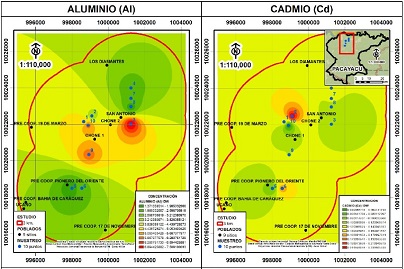Identif icación del potencial agrícola de suelos en la Amazonía Ecuatoriana, a partir de variables físico-químicas, microbiológicas y ambientales
DOI:
https://doi.org/10.28940/terra.v40i0.1294Palabras clave:
agroecosistemas, calidad de suelos, contaminación, remediaciónResumen
La productividad agrícola de la Amazonía Ecuatoriana es def iciente debido a la mala calidad del suelo, ocasionada por diversos contaminantes. El objetivo del presente estudio fue identif icar el potencial agrícola de suelos de la Amazonía Ecuatoriana, a partir de variables físico-químicas, biológicas y ambientales. Para esto, se tomaron 10 muestras de suelo de los principales agroecosistemas. Las variables físico-químicas se determinaron mediante técnicas estandarizadas. Para el conteo de bacterias (UFC/gr) se usó la metodología de recuento en placa y para la descripción ambiental se usaron variables espaciales (distancia a centros poblados) y espectrales (índice de vegetación de diferencia normalizada NDVI, infrarrojo cercano NIR, índice de vegetación mejorado EVI). A partir del pH, carbono orgánico y saturación relativa (Bases y Al+H) se def inieron índices de fertilidad potencial (IFP). Se presentó un pH ácido en todos los suelos y un porcentaje de materia orgánica menor al 2%, con un nivel promedio de Al y Al+H de 3.7 y 5.7 mEq 100 mL-1. Las relaciones de Ca Mg-1, Mg K-1 y (Ca+Mg) K-1 fueron de 7.7, 10.2 y 83.4. Se observó una relación signif icativa directa entre el pH y el Ca y Mg, con coef icientes de correlación de 0.67 y 0.80. El promedio IFP de los suelos fue 0.46, con rango de 0.33-0.65. La concentración de Cd y Pb fue 0.13 y 59.35 mg kg-1. El conteo de bacterias presentó valores altos en dos muestras (2.64×108 y 2.13×108). El 70% de las áreas se corresponden con el uso de suelo tierra agropecuaria-pastizal. La menor variación se observó en el NDVI, que tuvo un promedio de 0.77. El área central de la zona de muestreo tuvo altos niveles de contaminantes (Al, Cd, Pb), así como la zona de inf luencia alrededor de estos puntos. Es necesario implementar estrategias de remediación, para favorecer las prácticas agrícolas.
Descargas
Publication Facts
Reviewer profiles N/D
Author statements
- Academic society
- Terra Latinoamericana

















